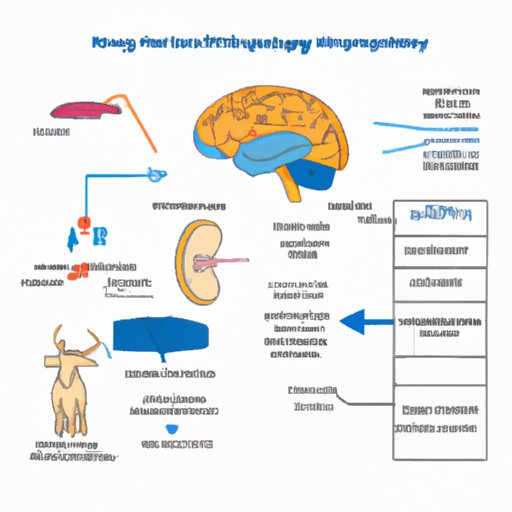Introduction
The sense of smell is one of our five senses that allow us to interact with the world around us. It’s an important tool for detecting danger, recognizing different smells, and even forming memories. But how does the sense of smell work? In this article, we explore the anatomy, physiology, and genetics of the olfactory system to gain a better understanding of how the sense of smell works.
Exploring the Anatomy of the Olfactory System
The olfactory system is made up of several structures that work together to detect and process odors. The main components include the nasal cavities, nasal conchae, olfactory epithelium, olfactory bulb, and olfactory tract. The nasal cavities are located in the nose and consist of two hollow spaces lined with mucous membranes. The nasal conchae are curved plates of bone that help increase the surface area of the nasal cavity, allowing air to enter more easily. The olfactory epithelium is a thin layer of tissue located at the back of the nasal cavity that contains special receptor cells responsible for detecting odors. These cells send signals to the olfactory bulb, which is a structure located at the base of the brain. The olfactory bulb then sends these signals to the olfactory tract, which transmits them to other parts of the brain where they are processed and interpreted.
Investigating the Physiological Process of Smell
The physiological process of smell begins with the detection of odor molecules. Special receptor cells located in the olfactory epithelium are responsible for detecting these molecules. When an odor molecule binds to a receptor cell, it triggers a signal that is sent to the olfactory bulb. The olfactory bulb then sends the signal along the olfactory tract to other parts of the brain, such as the amygdala and hippocampus, where it is processed and interpreted. This is how we are able to recognize different smells.

Examining the Role of Receptor Cells in Smell
Receptor cells play a key role in the sense of smell. These cells are located in the olfactory epithelium and come in two types: ciliated and microvillar. Ciliated receptor cells have tiny hairs called cilia that vibrate when an odor molecule binds to them. Microvillar receptor cells have small projections called microvilli that bind to odor molecules. Both types of receptor cells are capable of detecting odors, but ciliated cells are more sensitive and can detect a wider range of odors.
Analyzing the Signaling Pathway for Smell Perception
Once an odor molecule binds to a receptor cell, a signal is sent to the olfactory bulb. The olfactory bulb then sends the signal along the olfactory tract to other parts of the brain, such as the amygdala and hippocampus. Neurotransmitters, such as glutamate and gamma-aminobutyric acid (GABA), play an important role in transmitting the information about the odor to the brain. Once the information reaches the brain, it is processed and interpreted.

Understanding the Impact of Genetic Variations on Sense of Smell
Genetic variations can have a significant impact on our sense of smell. Certain genetic variations can lead to impaired sense of smell, while others may make it easier to detect certain odors. For example, some people have a genetic variation that makes them more sensitive to the smell of musk. Other examples of genetic variations that influence smell include those that affect the number of receptors, the sensitivity of the receptors, or the neurotransmitters involved in transmitting information about odors to the brain.

Investigating the Link between Memory and Smell
The sense of smell is closely linked to memory formation. The hippocampus, a part of the brain responsible for forming memories, plays an important role in this process. Odor cues can trigger memories of past experiences, such as the smell of freshly baked cookies reminding us of childhood holidays. This connection between smell and memory helps us to recall memories more easily.
Conclusion
In conclusion, the sense of smell is a complex process involving the anatomy, physiology, and genetics of the olfactory system. Receptor cells located in the olfactory epithelium are responsible for detecting odor molecules and sending signals to the olfactory bulb. The olfactory bulb then sends the signals along the olfactory tract to other parts of the brain, where they are processed and interpreted. Genetic variations can also have an impact on our sense of smell, while odor cues can help us to recall memories. Further research is needed to better understand the underlying mechanisms of the sense of smell.
(Note: Is this article not meeting your expectations? Do you have knowledge or insights to share? Unlock new opportunities and expand your reach by joining our authors team. Click Registration to join us and share your expertise with our readers.)
